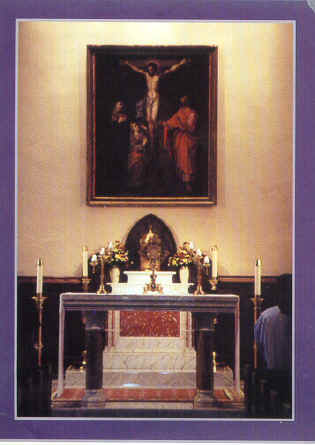|
Famous
Crucifixion painting is recovered
and restored to its place above the altar
Christopher
Gaul
Catholic
Review
Oct 12,
2001. A priceless sentimental
treasure of Mount St. Mary’s College and
Seminary in Emmitsburg has been restored
to a place of pious honor above the
seminary chapel’s altar after gathering
dust in the archives for nearly a century.
 The
recovery involves a story that spans
almost two centuries and an old painting
under which the Mount’s founder, Bishop
John DuBois, celebrated Mass and whose
profoundly touching scene must often have
held the saintly gaze of his neighbor and
friend, Elizabeth Ann Seton. The
recovery involves a story that spans
almost two centuries and an old painting
under which the Mount’s founder, Bishop
John DuBois, celebrated Mass and whose
profoundly touching scene must often have
held the saintly gaze of his neighbor and
friend, Elizabeth Ann Seton.
How the
striking 18th century oil painting of the
crucifixion languished for so long and how
it was discovered involved luck, intuition
and some quick-thinking historical
detective work on the part of an associate
professor of history at the college.
"Something
clicked when I saw it," said Father
Albert H. Ledoux, the faculty member who
is a 1987 graduate of the seminary.
It’s a
cryptic observation that requires some
explanation. Father Ledoux referred
specifically to the superb 18th century
copy of the famous 17th century Flemish
artist, Franz Francken the Younger’s
depiction of the Blessed Virgin Mary, St.
Mary Magdalene and St. John standing in
sorrow at the feet of the crucified
Christ.
"OK,
let’s start at the beginning,"
Father Ledoux advised. And this is his
story; this is the mystery he solved.
It was
1991, and the seminary had undergone a
thorough interior renovation. The building
had been practically gutted, what with the
installation of new heating and electrical
systems, among other things. But when it
was all done, many of the walls,
especially those in the large classrooms,
appeared even barer than they had before.
So, Monsignor Kenneth Roeltgen, then the
seminary rector, dispatched a staff member
to the college’s archives to find
"things to hang." One of the
"things" turned out to be the
crucifixion painting, darkened by the
ravages of time, but its poignant scene
still discernable.
It was
just the thing for the lecture hall.
It
remained there, little noticed, until 1995
when Monsignor Roeltgen decided the
crucifix above the altar of St.
Bernard’s, the seminary chapel, needing
restoring. He wanted something to fill the
blank space during its absence, and he
remembered the crucifixion painting in the
lecture hall. And so it was done.
Enter
Father Ledoux. He was spending the summer
at the Mount while working on his doctoral
dissertation at The Catholic University of
America. Entering the chapel for Mass one
morning he took a close look at the
painting above the altar. And that, he
said, is when "something
clicked."
As a
church history-buff student at the
seminary, Father Ledoux had spent many
hours in the college archives, sifting
through letters and other old documents.
Now was his chance to take on yet another
role, that of G.K. Chesterton’s famous
fictional priest detective, Father Brown.
Could this painting, thought Father Ledoux,
be the one that might have hung over the
altar of the old Mountain Church built
then by Father DuBois in 1806, the church
used by Mount students until 1897 and
which burned down July 4, 1913, the victim
of an errant Roman candle firework?
The
priest returned to the familiar archives
and after a search of several hours
uncovered a letter he thought he might
have glanced at during his student days.
It was from Bishop DuBois, dated 1835, in
which the Mount founder reported that he
had received the "crucifixion scene
in the Mountain Church" as payment
for a debt.
Father
Ledoux’s continuing investigation in the
archives revealed that a Mathias
O’Conway of Philadelphia had presented
the painting to Bishop DuBois as a
payment-in-kind for $244 in outstanding
fees for his son, Columbkill O’Conway,
who was a student at the Mount from 1809
to 1812.
Since
Bishop DuBois testified to having received
the painting, and there was no mention in
the college records of the O’Conway debt
after 1814, Father Brown, that is to say,
Father Ledoux surmised that the seminary
must have been given the painting around
that date or at least before Bishop DuBois
left the Mount for New York in 1826.
But was
this really the same crucifixion painting?
And had it, in fact, hung above the altar
of the Mountain Church, which is now the
site of the sky-soaring Pangborn
Campanile, the 80-foot bell tower
surmounted by a 25-foot tall golden statue
of the Blessed Virgin Mary?
Yet
another search through the archives
uncovered some photographs taken in the
late 1880s and early 1890s that revealed a
painting of the crucifixion above the old
Mountain Church’s high altar.
"The
photos were old, but you could clearly see
Christ and Mary Magdalene, and there was
no doubt in my mind it was one and the
same painting." said Father Ledoux.
"It’s
a such great story, isn’t it?" said
Father Kevin Rhoades, the seminary’s
present rector, who had the painting
professionally cleaned before restoring it
in August to its more appropriate place
above the chapel’s altar.
Like
Bishop DuBois, St. Elizabeth Ann Seton and
her Sisters of Charity and all the
Mount’s priests for almost the first
century of the 192-year-old seminary’s
existence, the seminarians can now draw
prayerful inspiration from an old
painting. It’s not even an original.
It’s a copy. It’s not even worth a lot
of money. But it’s precious beyond words
and something the seminary is not likely
to lose or neglect ever again.
Read
other stories on Mt. St. Mary
|